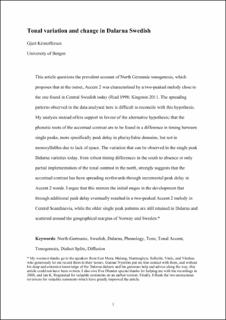| dc.contributor.author | Kristoffersen, Gjert | |
| dc.date.accessioned | 2021-08-04T08:19:39Z | |
| dc.date.available | 2021-08-04T08:19:39Z | |
| dc.date.created | 2021-05-21T15:29:06Z | |
| dc.date.issued | 2021 | |
| dc.identifier.issn | 1470-5427 | |
| dc.identifier.uri | https://hdl.handle.net/11250/2766114 | |
| dc.description.abstract | This article questions the prevalent account of North Germanic tonogenesis, which proposes that at the outset, Accent 2 was characterized by a double-peaked melody close to the one found in central Swedish today (Riad 1998, Kingston 2011). The spreading patterns observed in the data analyzed here are difficult to reconcile with this hypothesis. My analysis instead offers support in favor of the alternative hypothesis that the phonetic roots of the accentual contrast are to be found in a difference in timing between single peaks, specifically, peak delay in plurisyllabic domains, but not in mono-syllables due to lack of space. The variation observed in the single peak Dalarna varieties today, from robust timing differences in the south to absence or only partial implementation of the tonal contrast in the north, strongly suggests that the accentual contrast has been spreading northwards through incremental peak delay in Accent 2 words. I argue that this situation mirrors the initial stages in the development that, through additional peak delay, eventually resulted in a double-peaked Accent 2 melody in central Scandinavia. At the same time, the older single peak patterns are still retained in Dalarna and scattered around the geographical margins of Norway and Sweden. | en_US |
| dc.language.iso | eng | en_US |
| dc.publisher | Cambridge University Press | en_US |
| dc.rights | Attribution-NonCommercial-NoDerivatives 4.0 Internasjonal | * |
| dc.rights.uri | http://creativecommons.org/licenses/by-nc-nd/4.0/deed.no | * |
| dc.subject | Fonologi | en_US |
| dc.subject | Phonology | en_US |
| dc.title | Tonal variation and change in Dalarna Swedish | en_US |
| dc.type | Journal article | en_US |
| dc.type | Peer reviewed | en_US |
| dc.description.version | acceptedVersion | en_US |
| dc.rights.holder | Copyright Society for Germanic Linguistics 2021 | en_US |
| cristin.ispublished | true | |
| cristin.fulltext | postprint | |
| cristin.qualitycode | 1 | |
| dc.identifier.doi | 10.1017/S147054272000015X | |
| dc.identifier.cristin | 1911331 | |
| dc.source.journal | Journal Of Germanic Linguistics | en_US |
| dc.source.pagenumber | 179-233 | en_US |
| dc.subject.nsi | VDP::Nordiske språk: 018 | en_US |
| dc.subject.nsi | VDP::Nordic languages: 018 | en_US |
| dc.identifier.citation | Journal Of Germanic Linguistics. 2021, 33 (2), 179-233. | en_US |
| dc.source.volume | 33 | en_US |
| dc.source.issue | 2 | en_US |

